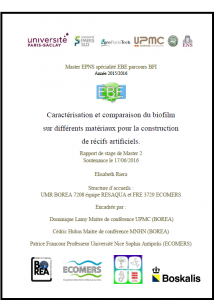
Biofilm study: first stage of colonization of artificial reefs
Marine Protected Areas
Master 2 internship report by Elisabeth RIERA, co-signed by the AMPN.
Biofilm study: first stage of colonization of artificial reefs.
Surface biofilm formation has been used as a bio-indicator of the quality of different artificial reef construction materials (concrete, reconstituted natural rock and dolomite) to establish the basis of a food web around them.
The communities of microorganisms forming these biofilms were studied by genomic fingerprinting to determine bacterial diversity and by pigment marker to determine the diversity of photosynthetic organisms.
Furthermore, the biochemical quality of extracellular polymeric substances (EPS), secreted by the biofilm communities, was studied by considering the proportions of proteins and polysaccharides and the nature and abundance of amino acids. Dolomite and the other two substrates bear dissimilar biofilms.
Concrete and natural rock present the classic characteristics of a marine biofilm, rich in bacteria and diatoms, secreting hydrophobic and negatively charged EPS and a dominant proportion of polysaccharides.
Dolomite does not seem to be an optimal material for the establishment of biofilms, which would be characterized more by communities of heterotrophic microorganisms, such as dinoflagellates and bacteria, lower ratios of polysaccharides to proteins and the presence of amino acids giving it a more negatively charged and more hydrophilic nature than other substrates.
